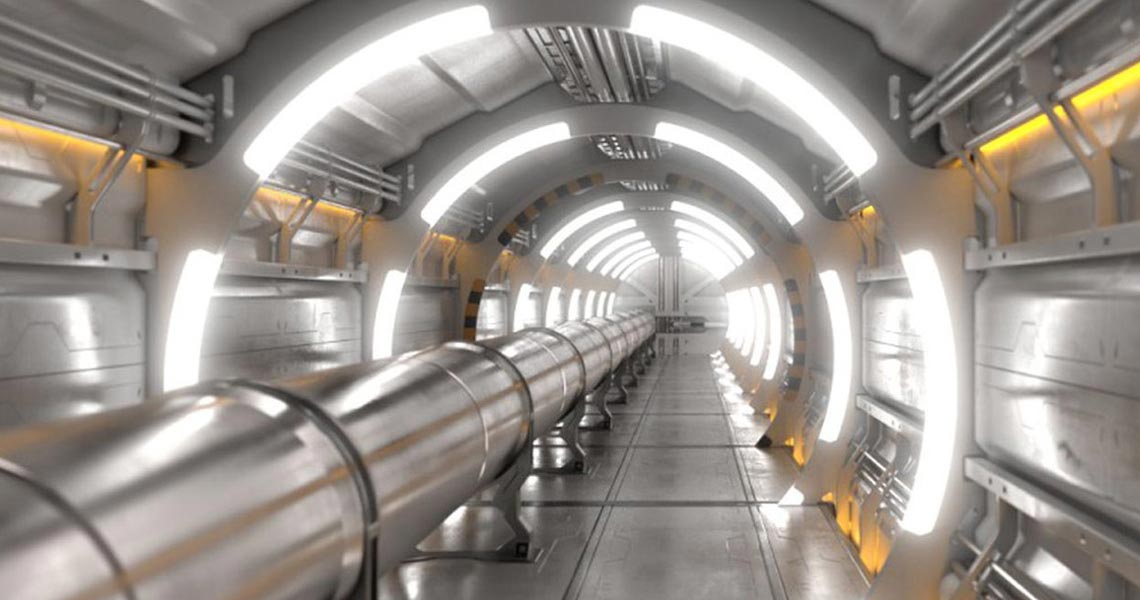Extract by CERN Courier 2023 May/Jun
MgB2 links at the HL-LHC
The discovery of superconductivity in magnesium diboride (MgB2) in 2001 generated new enthusiasm for HTS applications. This material,classified as medium-temperature superconductor, has remarkable features: it has a critical temperature (39K) some 30K higher than that of niobium titanium, a high current density (to date in low and medium magnetic fields) and, crucially, it can be industrially produced as round multi-filamentary wire in long (km) lengths.
These characteristics, along with a cost that is intrinsically lower than other available HTS materials, make it a promising candidate for electrical applications.
At the LHC the current leads are located in the eight straight sections. For the high-luminosity upgrade of the LHC (HL-LHC), scheduled to be operational in 2029, the decision was taken to locate the power converters in new, radiation-free underground technical galleries above the LHC tunnel. The distance between the power converters and the HL-LHC magnets spans about 100m and includes a vertical path via an 8m shaft connecting the technical galleries and the LHC tunnel. The large current to be transferred across such distance, the need for compactness, and the search for energy efficiency and potential savings led to the selection of HTS transmission as the enabling technology.
The electrical connection, at cryogenic temperature, between the HL-LHC current leads and the magnets is performed via superconducting links based on MgB2 technology. MgB2 wire is assembled in cables with different layouts to transfer currents ranging from 0.6kA to 18kA. The individual cables are then arranged in a compact assembly that constitutes the final cable feeding the magnet circuits of either the HL-LHC inner triplets (a series of quadrupole magnets that provides the final focusing of the proton beams before collision in ATLAS and CMS) or the HL-LHC matching sections (which match the optics in the arcs to those at the entrance of the final-focus quadrupoles), and the final cable is incorporated in a flexible cryostat with an external diameter of up to 220mm. The eight HL-LHC superconducting links are about 100m long and transfer currents of about 120kA for the triplets and 50kA for the matching sections at temperatures up to 25K, with cryogenic cooling performed with helium gas.
The R&D programme for the HL-LHC superconducting links started in around 2010 with the evaluation of the MgB2 conductor and the development, with industry, of a round wire with mechanical properties enabling cabling after reaction. Brittle superconductors, such as Nb3Sn – used in the HL-LHC quadrupoles and also under study for future high-field magnets – need to be reacted into the superconducting phase via heat treatments, at high temperatures, performed after their assembly in the final configuration. In other words, those conductors are not superconducting until cabling and winding have been performed. When the R&D programme was initiated, industrial MgB2 conductor existed in the form of multi-filamentary tape, which was successfully used by ASG Superconductors in industrial open MRI systems for transporting currents of a few hundred amperes. The requirement for the HL-LHC to transfer current to multiple circuits for a total of up to 120kA in a compact configuration, with multiple twisting and transposition steps necessary to provide uniform current distribution in both the wires and cables, called for the development of an optimised multi-filamentary round wire. Carried out in conjunction with ASG Superconductors, this development led to the introduction of thin niobium barriers around the MgB2 superconducting filaments to separate MgB2 from the surrounding nickel and avoid the formation of brittle MgB2–Ni reaction layers that compromise electro-mechanical performance; the adoption of higher purity boron powder to increase current capability; the optimisation in the fraction of Monel (a nickel-copper alloy used as the main constituent of the wire) in the 1mm-diameter wire to improve mechanical properties; the minimisation of filament size (about 55µm) and twist pitch (about 100mm) for the benefit of electro-mechanical properties; the addition of a copper stabiliser around the Monel matrix; and the coating of tin–silver onto the copper to ensure the surface quality of the wire and a controlled electrical resistance among wires (inter-strand resistance) when assembled into cables. After successive implementation and in-depth experimental validation of all improvements, a robust 1mm-diameter MgB2 wire with required electro-mechanical characteristics was produced.
The next step was to manufacture long unit lengths of MgB2 wire via larger billets (the assembled composite rods that are then extruded and drawn down in a long wire). The target unit length of several kilometres was reached in 2018 when series procurement of the wire was launched. In parallel, different cable layouts were developed and validated at CERN. This included round MgB2 cables in a co-axial configuration rated for 3kA and for 18kA at 25K (see “Complex cabling” figure). While the prototypes made at CERN were 20 to 30m long, the cable layout incorporated, from the outset, characteristics to enable production via industrial cabling machines of the type used for conventional cables. Splice techniques as well as detection and protection aspects were addressed in parallel with wire and cable development. Both technologies are strongly dependent on the characteristics of the superconductor, and are of key importance for the reliability of the final system.
The first qualification at 24K of a 20kA MgB2 cable produced at CERN, comprising two 20m lengths connected together, took place in 2014. This followed the qualification at CERN of short-model cables and other technological aspects, as well as the construction of a dedicated test station enabling the measurement of long cables operated at higher temperatures, in a forced flow of helium gas. The cables were then industrially produced at TRATOS Cavi via a contract with ICAS, in a close and fruitful collaboration that enabled – while operating heavy industrial equipment – the requirements identified during the R&D phase. The complexity of the final cables required a multi-step process that used different cabling, braiding and electrically insulating lines, and the implementation of a corresponding quality-assurance programme. The first industrial cables, which were 60m long, were successfully qualified at CERN in 2018. Final prototype cables of the type needed for the HL-LHC (for both the triplets and matching sections) were validated at CERN in 2020, when series production of the final cables was launched. As of today, the full series of about 1450km of MgB2 wire – the first large-scale production of this material – and five of the eight final MgB2 cables needed for the HL-LHC have been produced. Superconducting wire and cables are the core of a superconducting system, but the system itself requires a global optimisation, which is achieved via an integrated design. Following this approach, the challenge was to investigate and develop, in industry, long and flexible cryostats for the superconducting links with enhanced cryogenic performance. The goal was to achieve a low static heat load (<1.5W/m) into the cryogenic volume of the superconducting cables while adopting a design – a two-wall cryostat without intermediate thermal screen – that simplifies the cooling of the system, improves the mechanical flexibility of the links and eases handling during transport and installation. This development, which ran in parallel with the wire and cable activities, led to the desired results and, after an extensive test campaign at CERN, the developed technology was adopted. Series production of these cryostats is taking place at Cryoworld in the Netherlands.
The optimised system minimises the cryogenic cost for the cooling such that a superconducting link transfers – from the tunnel to the technical galleries – just enough helium gas to cool the resistive section of the current leads and brings it to the temperature (about 20K) for which the leads are optimised. In other words, the superconducting link does not add cryogenic cost to the refrigeration of the system. The links, which are rated for currents up to 120kA, are sufficiently flexible to be transported, as for conventional power cables, on drums about 4m in diameter and can be manually pulled, without major tooling, during installation (see “kA currents” image). The challenge of dealing with the thermal contraction of the superconducting links, which shrink by about 0.5m when cooled down to cryogenic temperature, was also addressed. An innovative solution, which takes advantage of bends and is compatible with the fixed position of the current lead cryostat, was validated with prototype tests.
Bridging the gap Shown on the left is a longitudinal cross-section of 4 mm-wide REBECO tape, picture from a different perspective in the middle panel, and on the right is a 10 mm-diameter REBCO cable 3kA currents at 6 o K.

kA currents Delivery and handling of the 120 kA Mgb2 cable assembly. The flexible, double-walled corrugated cryostat comprises 19 MgB2 superconducting cables in a single assembly, twisted together to from a compact bundle. Each MgB2 cable is about 140 m long with the bundle diameter around 90 mm.

kA currents Delivery and handling of the 120 kA Mgb2 cable assembly. The flexible, double-walled corrugated cryostat comprises 19 MgB2 superconducting cables in a single assembly, twisted together to from a compact bundle. Each MgB2 cable is about 140 m long with the bundle diameter around 90 mm.









